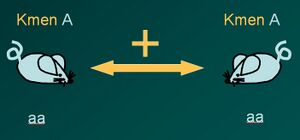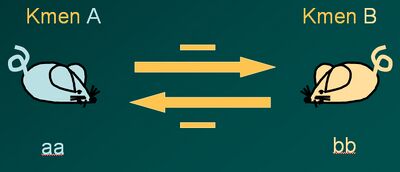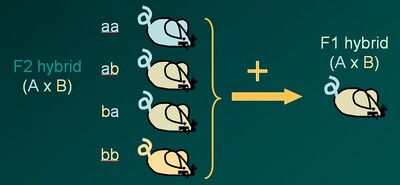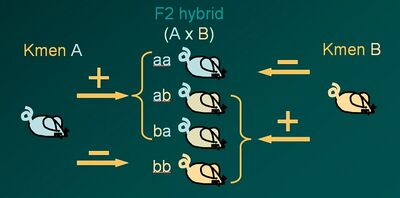Transplantation laws
In 1966, Snell and Stimpfling pronounced them based on their observations. They worked with inbred strains of laboratory animals, especially mice. Eventually they postulated 5 transplantation laws. To illustrate, consider two inbred strains of laboratory mice, A and B, differing only in allelesmi of a single histocompatibility gene.
1. transplantation law[edit | edit source]
Tissue transplanted between genetically identical members of the same strain is permanently attached. Syngeneic transplantation is successful.
2nd Transplant Act[edit | edit source]
Tissue transplanted between members of two inbred strains that differ in alleles of one or more histocompatibility systems is destroyed by the recipient. Allogeneic transplantation is unsuccessful. An individual of strain A (aa) reacts with an immune response against the antigen product of strain B (bb) and vice versa.
3rd Transplant Act[edit | edit source]
Tissue from individuals of both parental strains transplanted onto members of F1 hybrid generation is permanently attached, while tissue from F1 hybrid individuals is shed by members of both parental strains. As a result of codominance of histocompatibility genes, the antigenic products of the different alleles of the two parental strains are part of the F1 hybrid's alloantigenic makeup. The F1 hybrid is thus genetically inactive against the parental antigens, but on the contrary, its tissue induces an immune response in both parental strains.
4th Transplant Act[edit | edit source]
Tissue from F2 hybrid generation and all other generations is permanently attached by F1 hybrid recipients. This is because only different combinations of parental strain alloantigens (unless a locus is mutated), all of which are contained in the genotypes of the F1 hybrid, can occur in subsequent generations.
F1 hybrid of two inbred strains is a universal recipient of grafts from both parental strains and all types of progeny of their reciprocal crosses.
5th Transplant Act[edit | edit source]
Tissue of individuals of both parental strains is healed by part of the F2 hybrid generation and some of them survive permanently. In the example where the parental inbred strains differ by alleles of a single histocompatibility locus, we see that 75% of the parental grafts on F2 hybrid recipients survive.
Frequency of survival of parental grafts on F2 hybrid recipients[edit | edit source]
It decreases as the number of distinct histocompatibility loci increases.
- fx = frequency of permanently surviving grafts;
- n = the number of histocompatibility (H) loci by which the parental strains differ.
Estimating the number of H-locks[edit | edit source]
- differentiation between parental strains according to the number of their surviving skin grafts on F2 hybrids:







